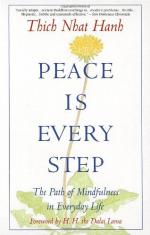
|
| Name: _________________________ | Period: ___________________ |
This test consists of 5 multiple choice questions, 5 short answer questions, and 10 short essay questions.
Multiple Choice Questions
1. According to Hanh's story about an arguing couple, what is the first step to healing?
(a) Apology.
(b) Conscious breathing.
(c) Forgiveness.
(d) Respect for others.
2. What does the author suggest using as a bell of mindfulness when driving in Montreal?
(a) Train tracks.
(b) "Je me souviens" license plate.
(c) Car horn.
(d) Stop signs.
3. What technique may be used to force the thought process to focus?
(a) Music.
(b) Dim lighting.
(c) Nature sounds.
(d) A mantra.
4. What enables one to become a real person?
(a) Studying the classics.
(b) Smiling at others.
(c) Practicing mindfulness.
(d) Greeting others.
5. In "Present Moment, Wonderful Moment", where is the perfect place to practice conscious breathing?
(a) In church.
(b) In nature.
(c) Anywhere.
(d) In solitude.
Short Answer Questions
1. In "The Eucharist", what does one bite of bread give to each disciple?
2. Who presents a smile openly without any goal?
3. What is mouth yoga?
4. What is Hanh's synonym for aimlessness?
5. What does Hanh compare to windows?
Short Essay Questions
1. How does the term departmentalization apply to most people's attitude towards meditation? Why is the attitude incorrect? How can society benefit by an attitude adjustment?
2. Which noted spiritual leader authors the foreword of "Peace is Every Step"? What is his attitude towards Hanh's work? How does this lend credibility to the book's teachings?
3. How does the process of conscious breathing affect one's work?
4. According to Hanh, what is an inappropriate use for meditation? What harm might be possible from using it inappropriately?
5. Which peace activist nominates Hanh for the Nobel Peace Prize? In what year does the nomination occur? Why does this individual nominate Hanh?
6. What is the Buddhist word for aimlessness? How does this word further extend the theme of living in the present?
7. How does Hanh simplify the process of conscious breathing so that it is an easy practice?
8. Explore the analogy of a new day being a gift to every being. Include details on how gifts are usually anticipated and acknowledged.
9. According to Hanh, humankind is a product of the environment. In order to avoid confusion and loneliness, what must one do? Why is it difficult for humankind to follow Hanh's advice?
10. What are the fundamental building blocks for harmony? How does creating harmony in one's own life benefit peace in the world?
|
This section contains 873 words (approx. 3 pages at 300 words per page) |

|




